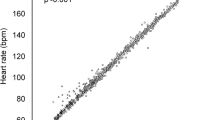Summary
The possibility of predicting the maximum oxygen intake from pulse measurements made 30–60 sec following a standard step test has been investigated. The population studied comprised 129 males ‘blue collar’ workers, ranging in age from 17 to 63 years, and varying widely in cardiorespiratory fitness.
The pulse rate in the final 10 sec of exercise could be estimated from the recovery pulse without systematic bias. The standard deviation of this estimate (6.8 beats/min) was equivalent to an additional 6–7% variation in the predicted maximum oxygen intake.
In large scale surveys where individual observers have limited experience, the prediction of the exercise pulse rate from the recovery pulse may be preferable to a biassed palpated measurement made during exercise.
Similar content being viewed by others
References
Åstrand, P.-O.: Physical fitness with special reference to sex and age. In “International Research in Sport and Physical Education”. Ed.E. Jokl andE. Simon. Springfield (Ill.): Thomas 1964.
—, andI. Ryhming: A nomogram for calculation of aerobic capacity (physical fitness) from pulse rate during sub-maximal work. J. appl. Physiol.7, 218–221 (1954).
Knehr, C. A., D. B. Dill, andW. Neufeld: Training and its effects on man at rest and at work. Amer. J. Physiol.136, 148–156 (1942).
Norman, R. W.: Unpublished report to Canadian Association of Health, Physical Education and Recreation, Fredericton, New Brunswick 1965.
Ryhming, I.: A modified Harvard step test for the evaluation of physical fitness. Arbeitsphysiologie15, 235–250 (1954).
Shephard, R. J.: On the timing of post-exercise pulse readings. Int. J. Sports Med. and Physical Fitness6, 23–27 (1966).
—: A comparison of paramagnetic and chemical methods for the determination of oxygen. Int. Z. angew. Physiol.22, 279–284 (1966).
—: A comparison of step test, bicycle ergometer, and treadmill in the assessment of cardio-respiratory fitness. Int. Z. angew. Physiol.23, 219–230 (1966).
- The prediction of “maximal” oxygen consumption using a new progressive step test. Ergonomics (in the press).
Taylor, C.: Some properties of maximal and sub-maximal exercise with reference to physiological variation and the measurement of exercise tolerance. Amer. J. Physiol.142, 200–212 (1944).
Author information
Authors and Affiliations
Rights and permissions
About this article
Cite this article
Shephard, R.J. The prediction of maximum oxygen intake from post-exercise pulse readings. Int. Z. Angew. Physiol. Einschl. Arbeitsphysiol. 24, 31–38 (1967). https://doi.org/10.1007/BF00693574
Received:
Issue Date:
DOI: https://doi.org/10.1007/BF00693574




